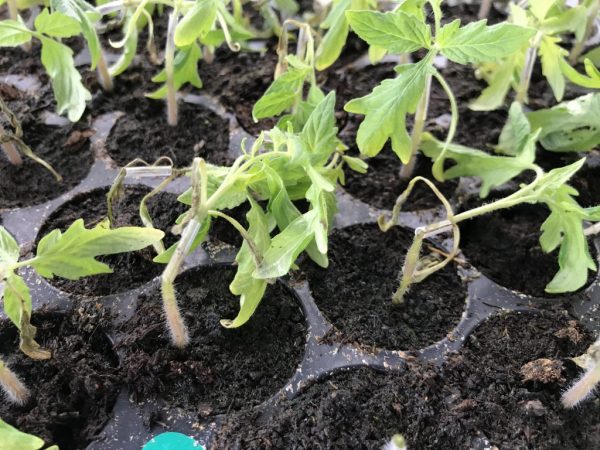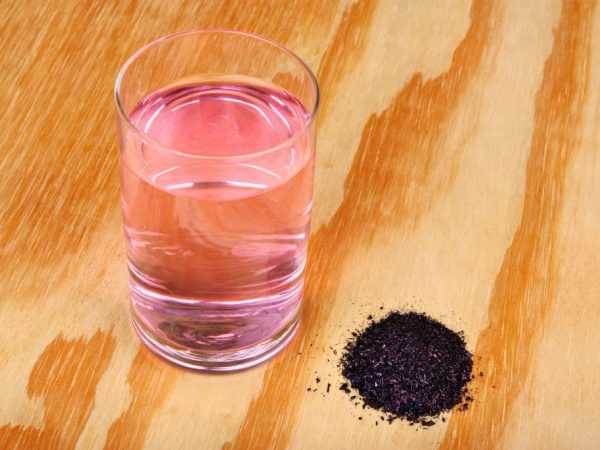What to do if the leg of tomatoes turns dark
Before planting seedlings in open ground, the gardener may experience the most unexpected difficulties. Black leg on tomatoes jeopardizes the whole future tomato harvest. You need to cope with the problem as quickly as possible, because every day of delay costs a person a good seedling.

Black leg on tomatoes
Black leg in tomato seedlings appears suddenly and very quickly spreads to crops planted in the neighborhood. If planting occurs in a greenhouse, the disease threatens both cabbage and cruciferous crops. How to deal with seedling disease?
Black leg: the reason for the appearance
The black leg is familiar to many experienced gardeners. Before you fight the disease of future tomatoes, it is worth identifying the root cause of the disease and eliminating it before it harms other crops. There may be only one reason for such a problem: a fungal disease that spreads quickly brings blackness to the legs of the seedlings. The fungus threatens all crops growing in greenhouses or greenhouses.
Several neighboring seedlings die from a fungal disease at once, destroying the future harvest of the gardener. The soil is a favorable environment for the fungus, and it is the soil that causes the disease of tomatoes. If the roots of the seedlings are diseased, the upper stems immediately thin out. Such a phenomenon as falling thin stems is a signal for the gardener that the root has been infected with a fungus.
Disease spread
An important condition for the spread of the disease is human hindsight. The carrier of the fungus is the soil, tools, which is used for processing roots and diseased plants. If the disease is not eliminated in a timely manner, all seedlings may suffer from the disease.
To treat tomato stems and eliminate the problem, a whole range of measures must be taken: elimination of the affected stems, cleaning the greenhouse from the fungus and further prevention. Only a quick reaction of the farmer and an integrated approach will help to solve the problem of plant diseases with a minimum level of losses.
Methods to deal with the problem
Techniques for dealing with blackleg in tomatoes are necessary for both an experienced farmer and a beginner. The affected plant is a threat to the entire greenhouse. If you follow the conditional instructions and recommendations of experienced gardeners, it will be possible to get rid of the black fungal disease in a short period.
It will be possible to overcome the disease if you take consistent actions:
- clean the greenhouse from the fungus;
- destroy spoiled seedlings;
- cure the stems of the remaining tomatoes and protect the neighboring crops (if it is possible to cure the damaged seedlings);
- fertilize new soil;
- protect the greenhouse from re-infestation by fungi.
The disease can be destroyed only by successive actions that are carried out in one day. You can't waste precious time.
A disease that did not have time to completely destroy the root system of the seedlings can be saved.Methods of dealing with black leg involve the treatment of seedlings with the help of special preparations.
Greenhouse cleaning
The first step is to stop the spread of the fungus, and for this to deprive the disease of a favorable environment. From the black leg, you should fight gradually, in several stages:
- In the first days, immediately after the traces of the black leg were identified, watering of the seedlings stops. You cannot help the fungus, spread even faster.
- As soon as the soil dries up, you need to do constant airing of the greenhouse. This must be done carefully, avoiding drafts or freezing of plants.
- Additionally, all condensate collected over several days is removed in the greenhouse. Fungal disease spreads only in a humid environment. Temporary dryness of seedlings is not threatened.
- The next stage is the most difficult - in order to stop the disease, you need to completely thin out all planted tomatoes. This should be done carefully, but very carefully. Even one black leg, left unattended, can harm healthy seedlings of tomatoes or other crops.
- The soil after the tomatoes is also removed from the greenhouse so that the seedlings are no longer threatened.
After that, a number of measures are carried out that are aimed at disinfecting all the soil. For these purposes, a solution of potassium permanganate is used. The whole soil is washed with a solution, and then it is dried. Dry soil is mixed with clean soil and then used for replanting. Formalin will not harm tomato seedlings if the gardener failed to get potassium permanganate.

A manganese solution will help to disinfect the soil.
Seedlings need to be sprinkled with more fertilizer or the amount of nitrogen in the soil should be increased. To do this, immediately after planting, tomatoes are fertilized with mineral complexes or wood ash is added. The quality of tomatoes in the future directly depends on the condition of the soil after the illness.
Seedling treatment
Blackleg progresses very quickly in acidic soil and kills everyone, even the strongest seedling of tomatoes or other crops. Plant treatment consists not only in the mass destruction of diseased seedlings, but also in the treatment of damaged crops. To make the disease disappear, use colloidal sulfur, in a concentration of no more than 5%. Treatment with potassium permanganate also shows good results. An inexpensive drug that prevents and destroys the disease, it is used before planting seeds and in cases where seedlings are urgently transplanted.
To combat the disease (manifested by the yellowness of the stems), use:
- Fitosporin;
- "Baktofit";
- Fitalovin (dosage 300 mg).
As soon as the disease manifests itself, most of the seedlings can be saved. Small seedlings are the first to suffer. If the stems are bent, the plant is thrown away, but yellow spots can still be fought. At the first manifestations of the fungus, the seedlings are sprayed with "Fitosporin". "Fitoferm" helps to correct another disease, which is similar in appearance to fungal diseases (roots and stems also darken from pests). If "Fitoferm" did not help, you should fight the fungal disease.
If the disease progresses rapidly, it will not be possible to save all the seedlings. The preparation for disinfection is suitable only for weakened, but untouched by the disease stems. For tomatoes that have already suffered, no drug will be a salvation. The disease stops only by jigging diseased stems (you need to fight the fungus decisively).
Folk ways of fighting
The black leg of the seedlings is treated if the problem is noticed in a timely manner. If the gardener is afraid to use chemistry, he can try one of the effective folk recipes:
- First of all, as in the treatment with "chemistry", so that the black leg of the tomato does not spread further, the person reduces watering. To prevent the tomato from drying out, it is watered with a spray bottle.
- To fight the fungus, the entire soil around the plants is covered with wood ash.
- To combat the fungus, a concentrated decoction of onion peels is used. Such measures will help to destroy the fungus in weak tomatoes with a clean leg.
To combat the fungus in tomatoes, special fertilizers containing nitrogen are used. In this matter, it is important not to overdo it, otherwise you can achieve the opposite results. All the measures taken are combined with the constant thinning of the rows. Each leg should be removed from neighboring crops and, in the event of a disease, can be easily removed.
In no case should manure be used to fertilize plants. Manure can contain many spores of the fungus, which enter a favorable environment (moist soil) and begin to multiply immediately.
Disease prevention
Timely preventive measures eliminate the need to remove a seedling affected by the fungus. If the gardener takes care of the culture so that each leg of the tomato is protected, there is no need to be afraid of the darkened rhizome.
Preventive measures are carried out even before planting seedlings. A leg or tomato seeds sits in the prepared soil. For these purposes, colloidal sulfur is used, with which seeds are processed. The soil is thoroughly frozen and ventilated before planting. Seedlings should not be planted in old soil from last year's crops. Airing and watering is organized in the greenhouse according to the schedule. Consistency in such a matter will only benefit the gardener. So that the leg of the tomatoes does not darken, the soil is periodically fertilized.
Conclusion
The black leg is a problem that can affect any gardener. Neither professionals nor beginners are immune from fungal disease. The speed of a person's reaction determines what kind of crop he will be able to harvest in the near future.
The sooner the fungus is stopped, the more seedlings can be saved. It is easier to restore some of the seedlings than to lose the entire greenhouse due to fungal disease. To treat a tomato, you will not need expensive drugs or excessive costs.


